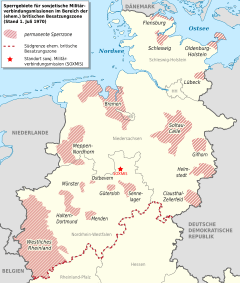Military liaison missions


The military liaison missions arose from reciprocal agreements formed between the Western allied nations (the US, the UK and France) and the USSR shortly after the end of the Second World War. The missions were active from 1946 until 1990.
The agreements between the allied nations and the Soviet Union permitted the deployment of small numbers of military intelligence personnel – together with associated support staff – in each other's territory in Germany, ostensibly for the purposes of monitoring and furthering better relationships between the Soviet and Western occupation forces. The British, French and American missions matched the size of the counterpart Soviet missions into West Germany (the nominal post-war British, French and American zones of occupations). The MLMs also played an intelligence-gathering role. The MLM teams were based in West Berlin but started their "tours" from the national mission houses in Potsdam in matte-olive-drab heavy cars. The Mission teams on a tour frequently comprised one officer accompanied by an NCO and a driver. The missions persisted throughout the Cold War period and ended in 1990 just prior to German reunification. The missions were
- British Commanders'-in-Chief Mission to the Soviet Forces in Germany (BRIXMIS)
- La Mission Militaire Francaise de Liaison (FMLM, more properly MMFL in French)
- U.S. Military Liaison Mission (USMLM)
and their reciprocal Soviet missions (SOXMIS/SMLM).
The British–Soviet missions were the first to be established (16 September 1946) under the terms of the Robertson–Malinin Agreement (the respective commanders-in-chief). It also had the largest contingent of personnel with 31 accredited team members. Later agreements with the US (Huebner–Malinin, March 1947) and France (Noiret–Malinin, April 1947) had significantly fewer permitted personnel, possibly because those Allied powers did not want large Soviet missions operating in their zones and vice versa.

The Allied liaison missions, having quasi diplomatic status, were relatively free to roam around East Germany save for specifically designated permanent and temporary restricted areas. They were largely 'untouchable' either by the law or military personnel. However a small number of team members were injured or killed in accidents or 'incidents' which gave rise to significant military and political tensions.
Little is publicly documented about the Soviet missions.
Although not widely known to the general public, the MLMs played a significant intelligence-gathering role during the Cold War. They also had a significant role in confirming that preparations for offensive action were NOT under way, thus reducing the tension.
Probably the most notable incident involving the American MLM was the death of Major Arthur D. Nicholson, a U.S. MLM Tour Officer. He was killed on March 23, 1985, shot by Soviet Army Sergeant Aleksandr Ryabtsev, and was considered the last American casualty of the Cold War, and the only U.S. MLM Officer to die in the course of duty, though other British and French tour personnel had died earlier. After the Berlin Wall fell in 1989, Nicholson's death was honored on the floor of both houses of the United States Congress, with a speech that was read into the official record.[1]
See also
References
- Fahey, John A. Licensed to Spy. Naval Institute Press. ISBN 1-55750-294-3.
- Geraghty, Tony. Brixmis: The Untold Exploits of Britain's Most Daring Cold War Spy Mission. HarperCollins. ISBN 0-00-638673-3.
- Gibson, Steve. The Last Mission: Behind the Iron Curtain. Sutton Publishing. ISBN 0-7509-1408-4.
- Holbrook, James R. Potsdam Mission: Memoir of a US Army Intelligence Officer in Communist East Germany. Cork Hill Press. ISBN 1-59408-534-X.
- Jan, Yves. Keep the Cold War cold. Artline films 2010.
External links
- Coldwarspies.com We Kept the Cold War Cool
- Western Allies Berlin site
- Allied MLM @ Parallel History Project
- Allied Museum Berlin
- BRIXMIS Association
- BRIXMIS display at the Military Intelligence Museum, Chicksands.
- MMFL Association
- USMLM Association
- History of the USMLM.
- USMLM research (honors thesis) by Anya Vodopyanov Part 1 and Part 2
- Lecture by Stephen V. Hoyt, Cold War Pioneers: The U.S. Military Liaison Mission, 1947–1990.
- Photos taken in East Germany while serving with USMLM